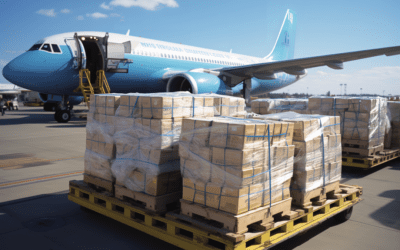The need to get shipments out quickly and efficiently is ever-growing in today’s transportation environment. Companies are now relying more on technology rather than spreadsheets and phone calls to streamline operations, making use of transportation management systems. These software solutions are essential for businesses wanting to improve their supply chain operation performances, streamlining operations with transportation management systems to enhance efficiency and effectiveness.
Article Overview
A transportation management system (TMS) is a viable option when it comes to transportation operations and streamlining operations. This system offers visibility in day-to-day operations and documentation to ensure the timely delivery of goods. TMS systems improve operational efficiency, save money, and create data-driven decision-making. Leveraging a TMS can enhance customer satisfaction and ultimately optimize operations.
But what exactly is a TMS, and how can it benefit a company?
What is a Transportation Management System?
A transportation management system is a platform that uses cutting-edge technology for business operations. A TMS can help companies optimize, plan, and execute the movement of goods and provide visibility and insights throughout the process. A typical TMS allows users to track shipments, schedule pickups, and deliveries, and generate reports. TMS solutions offer different features, and some enable companies to integrate with other software applications.
Integration with other systems could include enterprise resource planning systems, warehouse management systems, and order management systems. A TMS can consolidate information into a single dashboard, making price, carrier management, and load planning easier to locate and access rather than having it scattered across multiple sources.
Streamlining operations with transportation management systems can greatly benefit companies in managing their transportation operations effectively and efficiently.

Core Functions of a TMS
The primary functions of a TMS are to simplify operations, enhance visibility, and reduce costs. By implementing a TMS, studies show that businesses can achieve transportation cost reductions ranging from 5% to 30% through improved planning, optimization, and execution.
For any business, choosing the best carrier and selecting the most efficient and cost-effective mode of shipment based on distance is crucial. Having a TMS system in place can simplify this process.
Here are a couple of roles a TMS plays in modern-day logistics operations:
- Load Planning
Load planning involves determining the most efficient method for arranging and paying for shipments. The TMS uses advanced techniques to analyze factors such as weight and volume when using this system.
- Load Execution
After load planning is established, a TMS will help with load execution, which is the process of moving goods. Simply put, the TMS automates the tendering process by using the shipper’s route to tender loads digitally. Having the ability to track loads can provide real-time visibility on loads.
- Route Planning
Route planning is the process in which orders get delivered on the most efficient routes and the delivery sequence. Route planning involves using route optimization technology, which uses artificial intelligence, algorithms, or machine learning to quickly determine the most effective route. According to Inbound Logistics, route optimization can reduce mileage by 10% to 30% and improve on-time performance by 20% to 50%.
- Carrier Management
Carrier management systems are a piece of the TMS platform. A carrier management system allows users to manage carrier performance, track each shipment on delivery commitments, and report performance. It also helps manage contracts and negotiation rates with carriers, ensuring businesses get the most favorable prices and terms.
Who uses a TMS?
Many assume that TMS is only used by big businesses to help manage their complex supply chain, but it can be helpful for many industries managing shipments. Different sectors like eCommerce, third-party logistics (3PLs), distributors, and manufacturers can integrate TMS solutions. For any business, a TMS can be beneficial in tackling processes and optimizing operations.
- eCommerce
The eCommerce industry has experienced significant growth in recent years, leading to a need for more efficient transportation management processes. In eCommerce, timely and dependable shipping is crucial for meeting customer expectations and staying ahead of competitors. With the help of TMS, businesses can efficiently manage their operations, from processing orders and fulfilling them to tracking deliveries and providing customer support.
- Retailers
A TMS helps streamline the supply chain process for retail sectors by providing real-time visibility and control over shipments. A TMS communicates with a carrier to book shipments, generate labels, and gain tracking details.
- Distributors
Distributors play a crucial role in the supply chain by delivering products from manufacturers to retailers. With a TMS, distributors can easily track shipments, manage inventory, and coordinate deliveries.
- Third-Party Logistics
Implementing a TMS can simplify processes and offer benefits to 3PLs. 3PL providers can manage their clients’ transportation needs, including carrier selection, freight consolidation, and shipment tracking.
Benefits of a TMS
A transportation management system offers many benefits to a business, such as visibility, integrated systems, and increased automation. A TMS helps companies optimize transportation operations and increases productivity between the driver and the business.
Let’s break down just a few benefits that TMS provides to companies:
- Simplified Processes
With a TMS in place, businesses can streamline their process by integrating their systems. Instead of having select information scattered, companies can access one centralized portal that meets the needs of their business, making operations more efficient.
A TMS allows various systems, such as carrier selection, freight negotiation, and load tendering to be kept in one place. With everything in one place, businesses no longer need to search for information across multiple platforms.
- Tracking
With real-time visibility, companies can track goods throughout the delivery process, ensuring that the product gets from point A to B. For instance, if a load is experiencing delays, companies can proactively address those issues, which leads to customer satisfaction.
- Increased Efficiency
Time-consuming tasks such as manual load planning, carrier selection, and manual data entry can take up a significant amount of time. With a TMS, companies can increase automation by optimizing routes with algorithms, processing audits and payments, and having electronic documentation.
- Data Analysis
TMS solutions offer analytics and reporting capabilities to allow businesses to analyze transportation data, identify trends, evaluate carrier performance, and make data-driven decisions.
Data analysis can be helpful when a carrier consistently delivers late because the company can easily identify this and switch to a more reliable option. By collecting and analyzing transportation data, a company gains valuable insights into operations.
Key Considerations for Success
In today’s fast-paced world, efficient transportation management is essential for businesses across various industries. Whether the company is a small eCommerce store or a large corporation, businesses rely on efficient systems to streamline their supply chain operations.
Transportation management systems can also cut costs by helping reduce empty miles and minimize fuel consumption. TMS users report that solutions reduce freight costs by up to 15%.
A robust TMS enables automation tasks, reduces manual errors, and ultimately increases time-saving, ensures operational excellence, and delivers exceptional customer experiences. Businesses can optimize their operations, reduce costs, and enhance visibility by leveraging their core functions.






